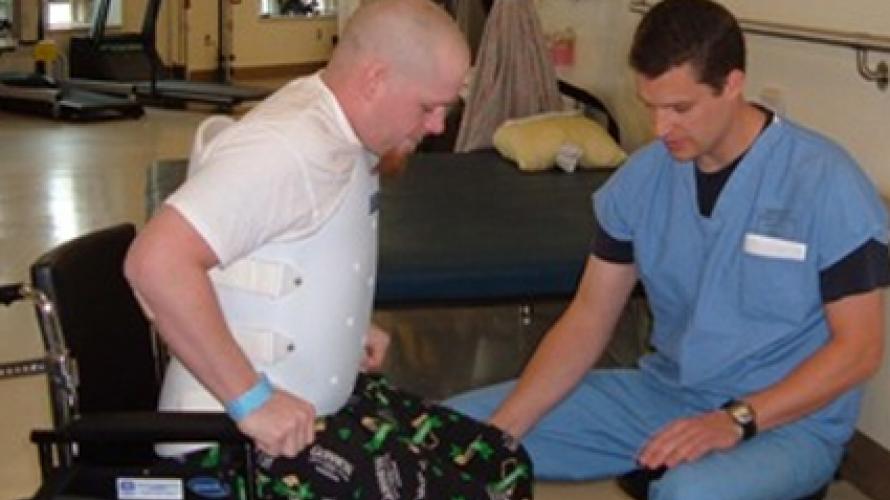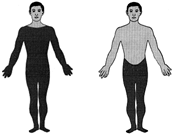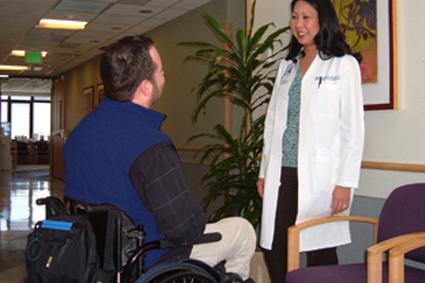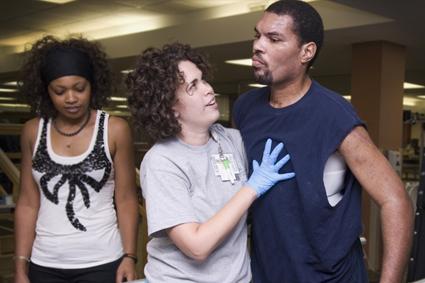
What is the spine?
The spine (also known as the “backbone”) is the connected column of bones running from your head to your lower back. A single bone is called a “vertebra” (pronounced VER-teh-brah), and multiple bones are called “vertebrae” (pronounced VER-teh-bray). The figure shows the spine and vertebrae.
The figure also shows the five sections of the spine. Each section is made up of a group of vertebrae.
- At the top of the spine, at your neck, is the cervical (C) section. There are 7 vertebrae in this section. Each vertebra is numbered top to bottom from C1 to C7.
- Below the cervical section is the thoracic (T) section. There are 12 vertebrae here. Each is numbered from T1 to T12.
- The lumbar (L) section follows. There are 5 vertebrae here. Each is numbered from L1 to L5.
- The next section is the Sacral (S) section. This is also called the “sacrum.” Here the 5 vertebrae are fused together as one bone.
- At the bottom of the spine, 3 to 5 vertebrae are fused together as one bone segment in the coccygeal (Cx) section. This is also called the “tailbone.”
What is the spinal cord?
The spine surrounds and protects the spinal cord, which is a fragile, dense bundle of nerves running from the base of your brain down through the open space in the vertebrae (also known as the spinal canal). The spinal cord ends near the L1 vertebra, but spinal nerve “roots” continue to run from the end of the spinal cord to the lower spinal canal.
What does the spinal cord do?
Your brain and spinal cord are part of your body’s nervous system. The brain is the command center for your body. The spinal cord is the nerve pathway that allows your brain and body to communicate.
Spinal nerves are another part of this message system. There are 31 pairs of spinal nerves branching from the left and right sides of the spinal cord. These nerve pairs are numbered to match the number of the vertebra nearest to where they leave the spine. For example, the T2 spinal nerves exit the spinal column below the T2 vertebra. When all the nerve pairs exit the spinal column, they begin to branch off into the many nerves that spread like a spider web to all parts of your body.
When your nervous system is working properly, it carries vital messages to and from your brain and body. The nervous system is a complex process, but the flow of messages basically control three important functions:
- Motor function is your ability to control the movement of your muscles.
- Sensory function is the sensation of touch, your ability to “feel” things.
- Autonomic function refers to the reflex actions that your brain controls without you having to think about it. Your blood pressure is one example..”
What is a spinal cord injury?
A spinal cord injury (SCI) is damage to the spinal cord or the spinal nerve roots within the spinal canal and resulting in temporary or permanent loss of movement and/or feeling.
What are common causes of spinal cord injury?
According to the National SCI Statistical Center, motor vehicle crashes are the most common cause of SCI. Accidental falls are the next most common cause of SCI, followed by acts of violence (mostly gunshot wounds).
What is “level of injury?”
This refers to your neurological level of injury. It is the lowest point on your body where you have normal muscle movement and feeling after SCI. Medical professionals find this point using the International Standards for Neurological Classification of SCI. The exam has two parts.
- Muscle strength tests are used to find the lowest point on your body where you have normal movement.
- “Pin-prick” and “light-touch” skin tests are used to find the lowest point on your body where you have normal feeling.
What is the difference between “complete” and “incomplete” injury?
When medical professionals find your level of injury, they also use the ASIA Impairment Scale (AIS) to grade the severity of your injury. The difference between complete and incomplete is whether or not you have any feeling in your anal area or you can tighten your anus.
- Complete injury – You do not have feeling in your anal area and cannot tighten your anus. This is graded as AIS A. Although your injury level is the lowest point where you have “normal” movement and feeling, you may or may not still have some feeling or movement below your injury level. It may extend one level or as much as a few levels below your injury level. This is your Zone of Partial Preservation.
- Incomplete injury – You have feeling in your anal area or can tighten your anus. Your grade depends on how much feeling or movement you have below your injury level. AIS B means you have feeling but not muscle movement below your injury level. AIS C means you have weak muscle movement below your injury level. AIS D means you have strong muscle movement below your injury level.
Why do I need to know the difference between complete and incomplete?
There is no sure way to tell if function will return after injury, but your potential for recovery is based on whether the severity of your injury is complete or incomplete [see "Understanding of Spinal Cord Injury: Part 2—Recovery and Rehabilitation"].
What is paralysis?

“Paralysis” is a word used to describe a loss in the ability to control muscle movement, but it often includes the loss of other functions, too. The degree of paralysis is greater for higher levels of injury compared to lower levels of injury. Examples:
- A person with a complete C4 level of injury is paralyzed from the shoulders down.
- A person with a complete T12 level of injury is paralyzed from the waist down.
What is tetraplegia?
“Tetraplegia” (pronounced tet-ra-ple-jah), also known as “Quadriplegia” (pronounced kwä-dr?-ple-jah) is paralysis caused by a cervical injury. It includes some degree of paralysis in both the upper body (shoulders, arms, hands, and fingers) and lower body (chest, legs, feet, and toes.
What is paraplegia?
“Paraplegia” (pronounced para-ple-jah) describes paralysis that results from a thoracic, lumbar, or sacral injury. It includes some degree of paralysis in the lower body (chest, legs, feet, and toes).
More in the "Understanding Spinal Cord Injury" series: Part 2—Recovery and Rehabilitation
Authorship
“Understanding Spinal Cord Injury: Part 1—The Body Before and After Injury” was developed and updated by Phil Klebine, M.A., in collaboration with the Model Systems Knowledge Translation Center.
Source: The content in this factsheet is based on research and/or professional consensus. This content has been reviewed and approved by experts from the Spinal Cord Injury Model Systems (SCIMS) centers, funded by the National Institute on Disability, Independent Living, and Rehabilitation Research (NIDILRR).
Disclaimer: This information is not meant to replace the advice of a medical professional. You should consult your health care provider about specific medical concerns or treatment. The contents of this factsheet were developed under a grant (number H133A110004) from the U.S. Department of Education (ED), National Institute on Disability and Rehabilitation Research (NIDRR). It was updated under a grant (number 90DPKT0009) from the National Institute on Disability, Independent Living, and Rehabilitation Research (NIDILRR). NIDILRR is a Center within the Administration for Community Living (ACL), Department of Health and Human Services (HHS). The contents of this factsheet do not necessarily represent the policy of NIDILRR, ACL, HHS, or ED and you should not assume endorsement by the federal government.
Recommended Citation: Klebine, P. (2022). Understanding spinal cord injury: Part 1—The body before and after injury. Model Systems Knowledge Translation Center (MSKTC). https://msktc.org/sci/factsheets/Understanding_SCI_Part_1
Copyright © 2022 Model Systems Knowledge Translation Center (MSKTC). May be reproduced and distributed freely with appropriate attribution. Prior permission must be obtained for inclusion in fee-based materials.

